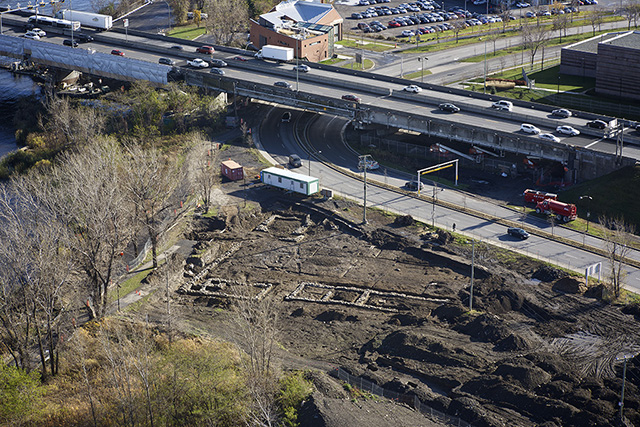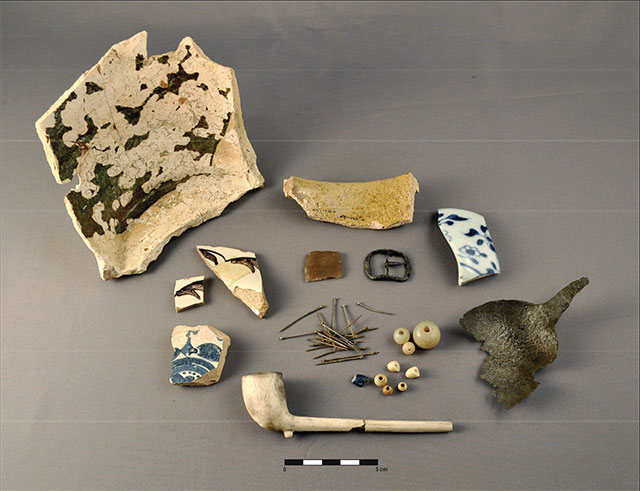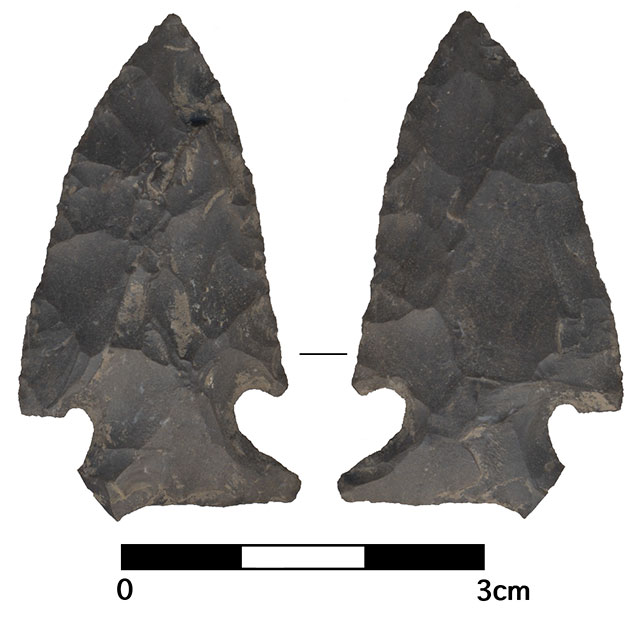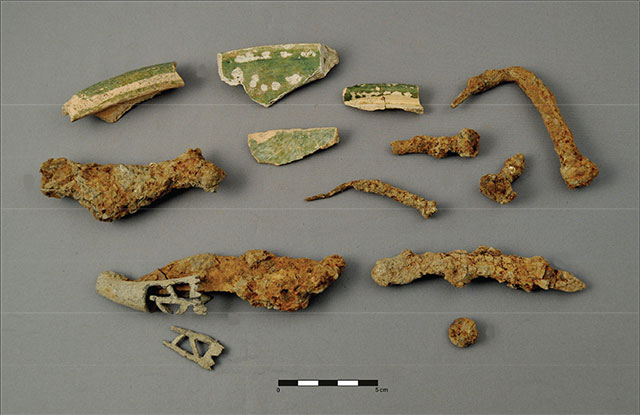Archeological Intervention on Île-des-Sœurs (2014)
Summary

Overhead view of the 2014 archeological excavation site on Île-des-Sœurs where the foundations of the Leber Site buildings dating back to the 17th century can be seen.
Throughout September and October, 2014, a large-scale archeological intervention was carried out at the LeBer site on Île-des-Sœurs in preparation for construction of a new bridge over the Saint Lawrence River. The firm Ethnoscop Inc. was awarded the contract to fully excavate the premises where a farm was built in 1664 and abandoned in 1790, and to perform an inventory of northern and eastern parts of the site that are off the farm premises, in areas that had already been identified as having been occupied during paleohistoric times. The purpose of the inventory was to gain a better understanding of the area surrounding the farm. For example, it was hoped that the inventory would help determine the presence of a western boundary of the premises and to locate the orchard and gardens mentioned in historical documents.
The 2014 inventory revealed paleohistoric vestiges mainly associated with late Woodland culture, as well as several elements from older periods. Two layers of remnants from the occupation period containing the remains of homes were found and linked to shards of aboriginal pottery and some stone tools. These findings were released with information from previous interventions, along with those from the adjacent paleohistoric site (BiFj-49), to produce an overview of the island's former occupation by Aboriginal people. Lastly, archaeobotanical analyses and organic phosphorous samples taken during surveys excluded the possibility that an orchard had existed northwest of the premises.
The full excavation of the area revealed poor preservation of archeological soils and of several vestiges, including the manor house. In addition, soil disruption at the western edge of the site made it impossible to identify traces of a wall or fence that closed in the premises. Despite these limitations, archaeologists unveiled the rest of the manor house, the stable, the bakery and the section of the wall closing the eastern side of the courtyard. Several new discoveries were made, such as a contemporary stone drain for the manor that captured grey water and directed it toward the river, and several configurations in the courtyard linked to 18th century farming practices. These discoveries shed light on the architectural changes made to the building and the use of the surrounding areas for agriculture. It was thus demonstrated that the manor's bastion was erected after the main building, but several years before the perimeter wall, possibly as a result of tensions caused by Aboriginal raids. Within the perimeter wall, there was a main alley for entering the establishment on the northern side. The alley's location was identified between the stable and the bakery, while the location of the manure pile and its gutter, covered with a wooden plank, were also located alongside various stake holes and poles associated with small gates for controlling the comings and goings of farm animals through the alley.
The collection of artifacts and ecofacts at the LeBer site revealed in 2014 is associated with the farm's occupation throughout the 18th century until it was abandoned by the Sisters of Congregation de Notre-Dame in 1790. It depicts the farmers as having been relatively comfortable (e.g., presence of faience ware), at the head of prosperous agricultural production (e.g., a zooarchaeological collection that shows the age curve of typical wear from optimal livestock methods).
Lastly, this geographic perspective of the LeBer site on Île-des-Sœurs shows the large scale of this agricultural practice in New France, which was comparable to the large properties owned by religious figures, and even the operations owned by the petite noblesse, in France.

Examples of some of the artifacts uncovered within the footprint of what would have been the manor of the Leber Site during the 2014 archeological excavation dating back to the 17th century, when a seigneural farm operated in the area.

Examples of arrow heads uncovered during the 2014 archeological excavation of the Leber Site.

Examples of some of the artifacts uncovered in the yard of the Leber Site during the 2014 archeological excavation dating back to the 17th century, when a seigneural farm operated in the area.
- Date modified: